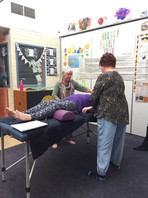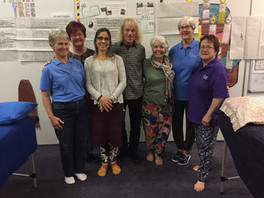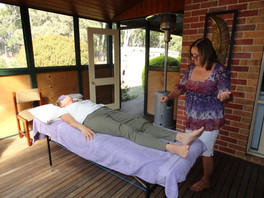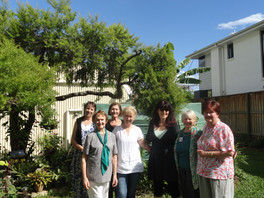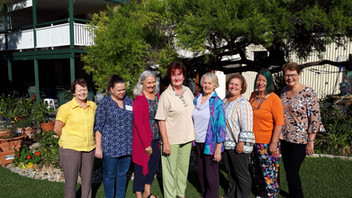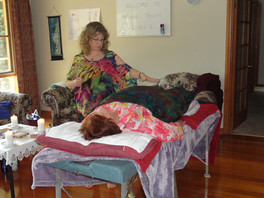Touch therapy belongs to the broad category of energy healing, which includes things acupuncture, tai chi, and reiki.
These approaches all operate on the premise that the body has a natural energy field that ties into the mind-body connection and plays a part in wellness.
According to energy healing theory, you’ll typically enjoy good health when energy flows easily throughout the body. Any imbalances or disruptions in the energy flow, however, can contribute to illness, pain, mental health symptoms, and other distress.
In touch therapy, practitioners use their hands to manipulate and direct the flow of energy — known as the biofield — throughout your body in order to promote healing and restore your body’s ability to heal itself.
The terminology around touch therapy can be a bit confusing, and it can mean different things to different people.
Some consider it an umbrella term for a variety of practices, including both healing touch (HT) and therapeutic touch (TT). Others use it as a synonym for TT.
Both HT and TT were developed by nurses and have similar treatment goals, but they differ in a few key ways.
Therapeutic touch
TT was developed by Dolores Krieger in the 1970s.
Despite the name, practitioners may not actually touch you during the session. Instead, they often hold their hands a few inches above your body, though they might use direct touch in some cases.
Healing touch
HT was developed in the late 1980s by Janet Mentgen. This approach combines a number of energy healing practices, including chakra connection and lymphatic release.
Practitioners consider it more of a treatment philosophy than a specific technique. Unlike TT, it usually does involve some level of touch, though this may depend on the specific technique used.
There’s some ambiguity on the exact use of touch in either approach. It can depend on different variables, including your practitioner and your level of comfort.
Sessions don’t necessarily require touch, so if you prefer a strictly hands-off approach, your therapist can likely accommodate your needs.
Your body has a great capacity for self-healing, but recovery from injury and illness takes time. Practitioners of touch therapy believe energy healing approaches can help this natural process happen more easily and rapidly.
People might use touch therapy to:
Many people report that touch therapy helps them feel calmer and more relaxed.
Touch therapy also shows some promise for helping people with terminal illness feel more at peace with the approaching end of life.
Anecdotal reports also suggest people often feel more confident and self-aware after a touch therapy session.
At your first appointment, your practitioner will get some background information about any symptoms you’ve noticed, how long you’ve had them, and any other health concerns you may have. They may also ask about your treatment goals or why you chose to try touch therapy.
You don’t need to take your clothes off for treatment, but it’s a good idea to wear clothes that allow you to sit and lie down comfortably. If you prefer your therapist not to touch you at all, mention this at the beginning of the session.
For the most part, HT and TT sessions proceed in the same general way. A typical session tends to last around 20 minutes, though times can vary depending on the symptoms you’re seeking treatment for.
Treatment usually involves the following stages.
Centering
Before beginning the treatment, your practitioner will take a few moments to focus their awareness and enter a semi-meditative state, often by using deep breathing and similar grounding exercises.
This helps them clear their mind of potentially distracting thoughts, so they can better focus on the treatment they’re about to provide.
Healing touch practitioners may also continue this process by setting an intention, or goal, for your treatment.
Assessment
To assess you, a therapist will hold their hands a few inches above you, slowly sweeping over your body from head to toe, in order to get a sense of your biofield.
In assessment, your practitioner attempts to find areas of what they believe is blocked energy, which touch therapists often describe as feeling warm, cool, or tingly.
If you only want treatment for a specific issue, such as chronic back pain, the touch therapist may focus on that area of your body.
Since healing touch often incorporates multiple techniques, your practitioner might use light touch or recommend other potentially helpful techniques.
Either way, trained touch therapists should always check in with you before trying new treatment techniques.
Intervention
After finding what they believe to be areas of disrupted or blocked energy, your practitioner will work to address those blockages.
They may make rhythmic hand motions over the area, almost as if they’re brushing wrinkles out of fabric. They may check in with you during the process to see if your symptoms improve and repeat this action, called “unruffling,” until they believe they no longer sense any blockages.
As part of the intervention, they’ll also use visualization techniques to direct positive energy toward these areas.
Evaluation
After several minutes, you may notice an increased sense of calm and relaxation. Once energy blockages seem to have cleared, the practitioner may do another quick assessment to check for any additional blockages before ending the session.
Once the session is over, you might notice sensations like:
- brief emotional overwhelm
- thirst
- lightheadedness
If you experience unpleasant or unwanted symptoms, let your practitioner know.
Feeling a little skeptical? That’s OK. It’s perfectly normal to wonder how someone can help you heal by accessing your energy field and “unruffling” blockages.
Experts haven’t found an answer to this question yet, although some evidence suggests touch therapies might have some benefits:
- Research from 2013Trusted Source suggests both HT and TT therapies may have some benefit for relieving pain, anxiety, and stress.
- Research from 2016Trusted Source suggests TT treatments may have some benefit in the treatment of eating disorders, specifically anorexia nervosa, by improving relaxation and strengthening the therapeutic relationship.
- A 2016 reviewTrusted Source suggests TT treatments may help relieve pain, nausea, and fatigue and improve quality of life for people with cancer.
- A small 2017 animal studyTrusted Source looked at 24 rats and found evidence to suggest daily use of TT treatments may help wounds heal more rapidly.
- A 2018 studyTrusted Source looking at 572 people with cancer found support for HT therapy as a method of pain relief.
- Results of a small 2019 studyTrusted Source looking at children with cancer found evidence to suggest acupressure and TT treatments may help improve well-being while receiving cancer treatment.
While these studies are promising, most of them are pretty small or have other issues with quality, and most authors agree that more research is needed.
It’s also hard to identify just how touch therapy might help people. Plenty of people notice improvement after touch therapy sessions, but experts can’t scientifically explain why or how. This makes it tricky to study touch therapy and other energy healing methods with research-driven approaches.
While the evidence behind touch therapy is spotty, researchers haven’t found any major risks associated with it. If you’re curious about trying it, there’s likely no harm in doing so, but you’ll want to keep a few things in mind.
First, remember these approaches aim to help relieve symptoms, not cure any illnesses. They should never be used as a replacement for treatment.
It can help to think of touch therapy like tea and chicken soup for a cold. The soup can’t cure you, but it can certainly help you feel better while you recover.
The same goes for mental health symptoms. Touch therapy may help lower stress levels and reduce anxiety, but there’s nothing to suggest it can resolve persistent, severe concerns, including depression, mood swings, or thoughts of suicide.
Some people also report that touch therapy helps with mild pain, fatigue, and muscle tension that their healthcare providers couldn’t explain. However, these symptoms can sometimes relate to mental health concerns, such as trauma or anxiety, so it’s best to consider following up with a mental health professional as well.
If you’d like to try touch therapy, always go for a certified practitioner.
Here’s what to look for:
- Healing touch. Providers should have the HTCP (Healing Touch Certified Practitioner) credential.
- Therapeutic touch. Providers should have the QTTP (Qualified Therapeutic Touch Practitioner) credential.
If you receive inpatient or outpatient medical care at a hospital or clinic, your care provider may be able to refer you to a practitioner on staff. If someone you know has recommended touch therapy, you can also ask for a referral.
At your first appointment, you can ask any questions you have about the process and get a sense of whether you feel comfortable with your provider. It’s important to find someone you feel relaxed with, so don’t hesitate to visit a few practitioners, if you need to.
Experts still have a lot to uncover about the potential use of body energy in healing, but there’s a lot to be said for the power of belief. If you expect something to work, it often helps.
At the end of the day, there’s no evidence to suggest touch therapy causes any harm, so this noninvasive approach could have some benefit for improving general physical and emotional wellness.
Crystal Raypole has previously worked as a writer and editor for GoodTherapy. Her fields of interest include Asian languages and literature, Japanese translation, cooking, natural sciences, sex positivity, and mental health. In particular, she’s committed to helping decrease stigma around mental health issues.






